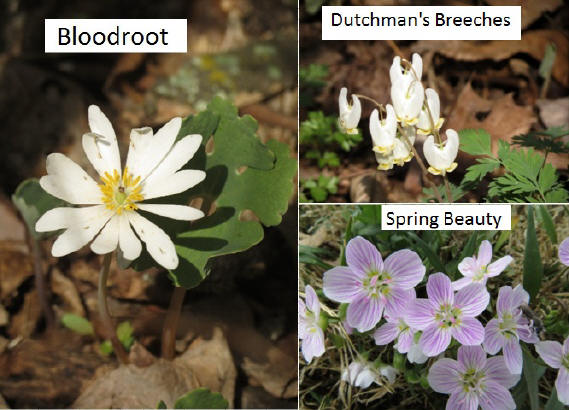 Springtime is a wonderful time of the year to enjoy the surprises of nature. One of my favorite activities is to take a walk and look for spring wildflowers poking up from their winter nap. Three beautiful wildflowers that I have observed are Bloodroot (Sanguinaria
Canadensis), Dutchman’s Breeches (Dicentra Cucullaria), and Spring Beauty (Claytonia Virginica.) They can be detected in woodland areas and they have been observed at the beautiful Gettysburg National Military Park. It is important to note that the wildflowers in the National Parks should never be removed because they are protected by federal law to conserve the scenery
and the natural and historic beauty of the environment.
Springtime is a wonderful time of the year to enjoy the surprises of nature. One of my favorite activities is to take a walk and look for spring wildflowers poking up from their winter nap. Three beautiful wildflowers that I have observed are Bloodroot (Sanguinaria
Canadensis), Dutchman’s Breeches (Dicentra Cucullaria), and Spring Beauty (Claytonia Virginica.) They can be detected in woodland areas and they have been observed at the beautiful Gettysburg National Military Park. It is important to note that the wildflowers in the National Parks should never be removed because they are protected by federal law to conserve the scenery
and the natural and historic beauty of the environment.
Bloodroot (Sanguinaria Canadensis) is a stunning, perennial wildflower found in the woodlands of Pennsylvania. It is derived from the Papaveraceae (Poppy). It is becoming a popular flower for shade gardens because of its exquisite beauty. A thick six to eight inch stem pushes out of the ground in March, revealing a single leaf tightly rolled around a large flower bud.
When it unfurls, the light green leaf is four to eight inches wide and generally rounded in shape but with an irregular margin and wavy edges. The foliage remains attractive until the entire plant disappears in late summer. Its name comes from the blood-red sap, which was once used as a respiratory aid by Native Americans and the blood of the root was used as a dye. The
flowers of the bloodroot plant are pollinated by small bees.

Dutchman’s Breeches (Dicentra Cucullaria) is a perennial herbaceous plant. It is a small, graceful native wildflower with fern-like foliage and unusual flowers that bloom during March through May. It can be found in moist woodlands and wooded valleys. The common name Dutchman’s breeches derives from their white flowers that look like white pantaloons or breeches. Their
seeds are spread by ants, a process called myrmecochory. Myrmecochorous plants produce seeds with elainosomes, a fleshy organ that attracts ants. The ants take the seeds to their nest, where they eat the elaiosomes and put the seeds in their nest debris, where they are protected until they germinate. The seeds get the added bonus of growing in a medium made richer by the
ant nest debris. The flower droops from leafless stems arching above the foliage in early spring. Plants typically grow to 12" tall with the flower stems and basal leaves rising directly from a scaly rootstock. They are in the same genus as bleeding heart. They like moist, well-drained soil in part shade to full shade. Native Americans considered this plant useful for
syphilis, skins conditions, and as a blood purifier.
The Spring Beauty wildflower (Claytonia Virginica) is a native perennial. It is a small, low-growing wildflower that has a star-like cluster of five white to light pink flowers. Closer examination of the petals will reveal an array of fine pink stripes and a pleasant floral fragrance. The foliage continues to grow after the bloom and may reach close to a foot tall
before the leaves disappear in late spring. Spring Beauty grows from tubers that provide nutrition to the plant.
Remember that it is against the law to remove wildflowers from any National Park. Though you may be tempted to grab a few bunches of wildflowers on your next hike, wildflowers should be left in the wild to be enjoyed by all.
Read other articles on ecological gardening & native plants
Read other articles by Carolyn Black